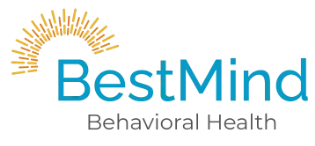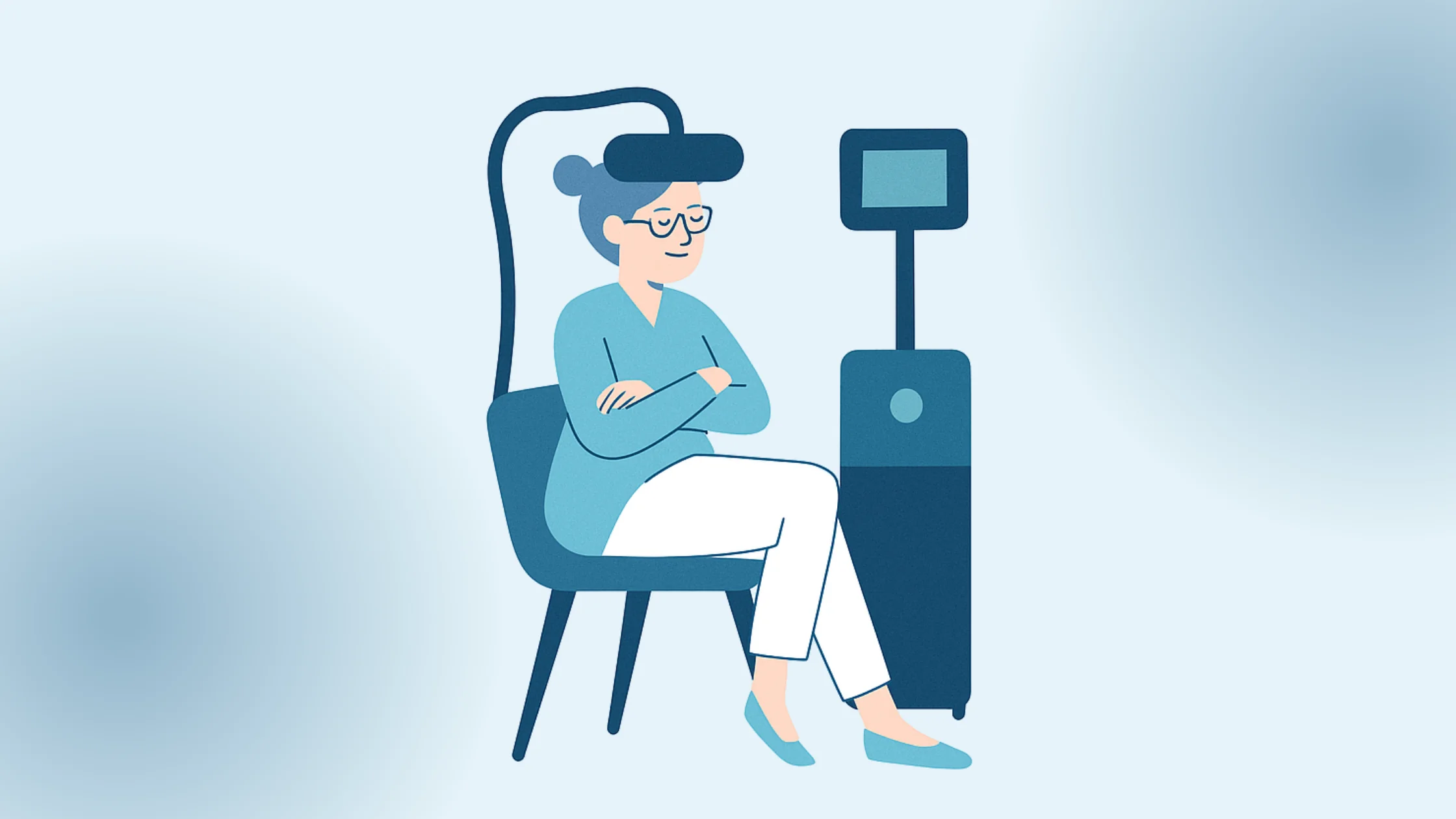
M.D. Medical Director, Psychiatrist
Repetitive TMS (rTMS) and deep TMS are the two main forms of transcranial magnetic stimulation (TMS) therapy. Both of these treatments use magnetic pulses to stimulate specific areas of the brain involved in mood regulation, but they differ in how they reach those areas and the conditions they’re approved to treat.
In this guide, we’ll explain how rTMS and deep TMS work, the differences between these two treatments, as well as their similarities.
What is TMS?
Transcranial magnetic stimulation (TMS) is a non-invasive treatment that uses gentle magnetic pulses to stimulate specific areas of the brain involved in mood regulation. It’s most commonly used to help people living with depression, particularly when traditional treatments like medication or therapy haven’t provided relief (also known as treatment-resistant depression or TRD).
During a TMS session, a small electromagnetic coil is placed against the scalp. This coil sends focused magnetic pulses into the brain, targeting regions that are often underactive in people with depression and other mental health conditions. Over time, these pulses help reset and strengthen the brain’s natural communication pathways to improve mood and emotional balance.
Here’s a step-by-step look at how TMS works:
- A magnetic coil is positioned on the head
- The coil sends pulses that stimulate nerve cells in mood-related regions of the brain
- These pulses encourage healthier brain activity over time
- Many patients begin to feel relief from depression symptoms after several sessions.
TMS is performed in an outpatient setting, which means there’s no need for anesthesia or a hospital stay. Each session lasts between 20 to 40 minutes and the treatment is well-tolerated and generally painless. Most people describe the sensation as a light tapping on the scalp, and earplugs are often provided to soften the clicking sound of the machine. Some may experience mild side effects but these are usually temporary and resolve on their own.
Read: Who Qualifies for TMS Therapy? (TMS Requirements)
Before starting TMS treatment, patients go through a ‘brain mapping’ session to determine the best placement and intensity of the magnetic pulses. These settings are then used for the rest of the treatment course and adjusted when needed. This personalization is one of the key advantages of TMS as it ensures the correct brain region is being targeted for each individual.
TMS has been FDA-approved for treating depression since 2008. It is also increasingly being studied and used off-label for conditions like anxiety, bipolar disorder, post-traumatic stress disorder (PTSD), and a range of other mood disorders and neurological conditions.
TMS therapy is sometimes referred to as repetitive transcranial magnetic stimulation (rTMS) due to the repetitive nature of the magnetic pulses.
What is deep TMS?
Deep transcranial magnetic stimulation (deep TMS) builds on the same principles as traditional TMS, only it reaches further into the brain. This type of TMS uses specialized H-coils which can penetrate deeper brain structures than traditional TMS. This allows for more focused and precise stimulation that may have a more powerful impact on brain circuitry.
During a deep TMS session, the H-coils are placed inside a padded helmet that fits comfortably on the head. Targeted brain areas are then gently stimulated with repeated pulses that help reset and regulate mood-related neural activity – just like with rTMS, except deeper.
Deep TMS has shown promising results for people with treatment-resistant depression, and it’s the only TMS technology that’s been FDA-cleared to treat both obsessive-compulsive disorder (OCD) and smoking cessation. Like traditional TMS, it’s non-invasive, doesn’t require anesthesia, needs minimal recovery time, and has few side effects. Treatment sessions are also similar in length and most patients can return to their daily activities immediately afterwards.
Learn More: How Successful is TMS Therapy?
The differences between repetitive TMS and deep TMS
Now that we have a good understanding of how traditional TMS (rTMS) and deep TMS work, let’s dive deeper into the differences between these two treatments.
Stimulation depth and brain targets
The main difference between rTMS and deep TMS is how deeply the magnetic fields reach into the brain.
rTMS targets surface-level regions – usually the dorsolateral prefrontal cortex (DPFC), a part of the brain linked to executive function, memory, and emotional regulation. The figure-8 coil used in rTMS reaches about 1 – 1.5 cm into the brain.
Deep TMS uses an H-coil that can reach approximately 3 – 4 cm into the brain, stimulating broader and deeper neural networks – including the subgenual anterior cingulate cortex, which is often associated with reward, motivation, and mood regulation.
This deeper stimulation means deep TMS can engage with brain circuits that are more difficult to reach with traditional rTMS, potentially offering benefits for people with more treatment-resistant symptoms.
Coil design and coverage
As mentioned above, rTMS uses a figure-8 coil while deep TMS uses a H-coil. The difference between these two coil types is significant:
- The figure-8 coil directs the magnetic field to a small, focused area. This can result in a narrower scope of stimulation that may miss some relevant brain structures, unless guided by advanced imaging or neuronavigation systems.
- The specially-designed H1-coil used in deep TMS delivers the magnetic field radially, which allows for a broader and deeper reach. This means deep TMS stimulates a larger volume of brain tissue (approximately 17cm³ compared to rTMS’s ~3cm³), which may improve clinical outcomes – especially if precision targeting is difficult.
FDA approvals and conditions treated
Both rTMS and deep TMS are FDA-approved to treat major depressive disorder (MDD), but deep TMS is also approved for OCD and smoking cessation. In Europe, the treatment has received the CE mark for a broader range of neurological and psychiatric conditions, including PTSD, bipolar disorder, and Parkinson’s disease.
rTMS is also FDA-approved for certain types of migraine.
Effectiveness
Emerging research suggests that deep TMS may offer stronger or faster symptom relief for certain individuals, particularly those with moderate-to-severe depression or those who haven’t responded to other treatments.
In one 2019 study published in the Journal of Psychiatric Research, combining deep TMS with medication was found to produce higher response rates compared to rTMS and medication, or taking medication alone.
Session length
There are slight differences in the length of sessions for rTMS compared to deep TMS. rTMS sessions typically last around 30 to 40 minutes and may involve more focused stimulation, while deep TMS sessions are typically shorter, lasting around 20 minutes because of the coil’s more broader penetration.
What rTMS and deep TMS have in common
rTMS and deep TMS may differ in how they deliver treatment, but they share a strong foundation. Both are brain stimulation treatments designed to help individuals find relief from symptoms of depression and other mental health conditions when other treatments haven’t been effective.
rTMS and deep TMS are both non-invasive, medication-free therapies that use repeated magnetic pulses to stimulate specific areas of the brain. Over time, these pulses help regulate neural activity in brain circuits that are often underactive or dysregulated in people with depression, OCD, and other conditions. As the brain’s natural rhythms begin to rebalance, many patients experience a meaningful improvement in mood and daily functioning.
Shared benefits between rTMS and deep TMS include:
- Safe and well-tolerated: Clinical trials show that both forms of TMS are generally safe, with minimal and temporary side effects such as a mild headache or scalp discomfort. One randomized, controlled study published in Clinical Neurophysiology confirmed that deep TMS is just as well-tolerated as traditional TMS, with no significant neurological or physical side effects observed in either group.
- Effective symptom relief: Both therapies have shown strong outcomes in treating major depressive disorder, especially when combined with medication.
- Integrated treatment options: rTMS and deep TMS can be used on their own or in combination with other treatments, such as antidepressants or psychotherapy.
Summary: rTMS vs deep TMS
To summarize, both repetitive TMS and deep TMS are effective, non-invasive treatments for depression, but there are key differences in how they work:
- Depth of stimulation: Deep TMS reaches approximately 3 – 4 cm into the brain, allowing it to access deeper neural structures involved in mood regulation. rTMS, on the other hand, typically reaches about 1 – 1.5 cm and is focused more on surface-level regions like the dorsolateral prefrontal cortex.
- Coil design: Deep TMS uses a specialized H1-coil that delivers magnetic pulses in a radial pattern, allowing it to cover a broader area of the brain. rTMS uses a figure-8 coil, which delivers pulses in a narrower, vertical field to a more localized target.
- Session duration: Deep TMS sessions are typically shorter, lasting around 20 minutes while rTMS sessions can take between 30 to 40 minutes, depending on the protocol.
The table provides a quick summary of the differences between rTMS and deep TMS:
| rTMS | DEEP TMS | |
| DEPTH OF STIMULATION | ~ 1 to 1.5cm (surface level) | ~ 3 to 4 cm (deeper brain regions) |
| TARGETED BRAIN AREAS | Dorsolateral prefrontal cortex | Subgenual anterior cingulate + broader networks |
| COIL TYPE | Figure-8 coil (narrow, vertical field) | H1-coil (wide, radial field) |
| MAGNETIC FIELD COVERAGE | Localized (about 3 cm³ of brain tissue) | Broad (up to 17 cm³ of brain tissue) |
| SESSION DURATION | ~ 30 to 40 minutes | ~ 20 minutes |
| FDA APPROVAL | Major depressive disorder, migraine | Major depressive disorder, OCD, smoking cessation |
Other types of TMS therapy
rTMS and deep TMS are just two types of TMS therapy. Other variations of this treatment include:
Theta burst stimulation (TBS)
TBS is a faster form of TMS that uses short bursts of high-frequency stimulation to mimic the natural rhythms of brain activity. This treatment has a much shorter session length, typically completed in under 10 minutes.
SAINT TMS
Stanford Accelerated Intelligence Neuromodulation Therapy (SAINT) is an advanced, FDA-approved form of TMS developed at Stanford University. It uses advanced imaging to precisely target areas of the brain and delivers a highly personalized, accelerated treatment schedule.
Learn More: What Makes SAINT TMS Different From Regular TMS?
Accelerated TMS (aTMS)
Accelerated TMS (aTMS) is a more intensive version of traditional TMS. It administers multiple sessions per day to condense the treatment timeline from several weeks to just one to two weeks. This approach is ideal for those seeking faster results or are unable to commit to a full TMS treatment schedule.
Read More: Accelerated TMS vs. Traditional TMS: Which One Makes Sense for You?
FAQ: Differences between repetitive TMS and deep TMS
What is TMS?
TMS stands for transcranial magnetic stimulation. It’s a non-invasive, FDA-approved treatment that uses magnetic pulses to stimulate areas of the brain involved in mood regulation, usually the prefrontal cortex. It’s a well tolerated treatment that doesn’t require anesthesia, and most patients can resume normal activities immediately after treatment.
What are the most common side effects of TMS?
The most common side effects of TMS are mild scalp discomfort and headaches. These usually fade shortly after treatment and resolve after a number of sessions. Learn more about TMS side effects here: TMS Side Effects: All You Need to Know
What is deep TMS?
Deep transcranial magnetic stimulation (deep TMS) uses a specialized H-coil to stimulate deeper parts of the brain. It reaches farther into the brain compared to traditional TMS and sessions are slightly shorter at just 20 minutes long.
Is TMS the same as electroconvulsive therapy (ECT)?
No, TMS and ECT are very different treatments. TMS is non-invasive and doesn’t require anesthesia or cause seizures. ECT, however, involves a small electrical current triggering a brief seizure under anesthesia. You can read more about the differences between TMS and ECT in this article: TMS vs. ECT: Which is better?
Is deep TMS more effective than rTMS?
Some studies suggest that deep TMS may offer greater symptom relief, particularly for those with treatment-resistant depression. This is because of its broader and deeper stimulation. That said, both types of TMS have shown to be effective and safe.
Is TMS the same as vagus nerve stimulation (VNS)?
No, vagus nerve stimulation involves surgically implanting a device to stimulate the vagus nerve. TMS is a non-invasive treatment that doesn’t require surgery or implants. It uses external magnetic coils to stimulate specific regions of the brain.
Explore rTMS and deep TMS with BestMind
If you’re exploring rTMS or deep TMS as a potential treatment option, we offer both of these therapies at our comfortable BestMind clinics in Colorado, Oregon, and Washington.
Whether you’re just starting your journey or looking for alternatives to medication, our team is here to help you find the right treatment for your needs. Contact us today to schedule a consultation and learn about your options.


